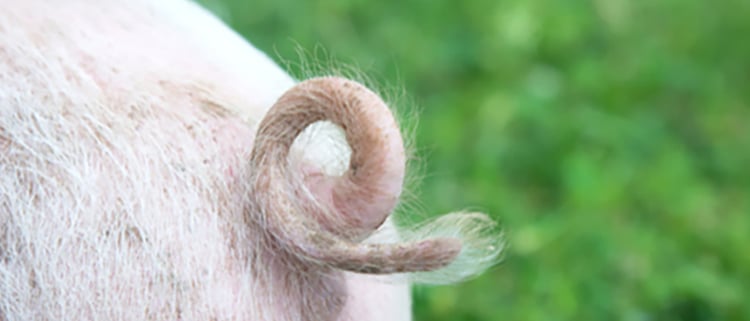Tail biting in pigs – How to spot early warning signs
Tail biting is an unpredictable and costly problem in pig herds. Understanding the early warning signs can help to reduce the associated losses. New precision livestock farming tools can make it easier to continuously monitor for the early warning signs on pig farms.
by Gwendolyn Jones
Causes for tail biting in pigs
The causes behind tail biting are highly complex and multi factorial. The lack of a single clear cause makes the problem hard to control.
It can be the result of aggressive attacks from other pigs caused by frustration. This can be due to management errors, e.g. overcrowding, ammonia levels, competition for feed or not enough enrichment materials.
Secondary tail biting involves tissue that has already been damaged e.g. through necrosis and inflammation. The smell of the injured tissue and appearance of blood attracts pigs to start nibbling and biting the affected area. This is how Swine Inflammation and Necrosis Syndrome (SINS) can be associated with it. More recent work suggests that oxidative stress causing inflammation and related death of cells could also play a role in the development of secondary tail biting. If there are too many dead cells, typically occurring at the ear tips and tails of the pigs, again the smell becomes different, thus attracting other pigs.
Cost of tail biting in pigs
Tail biting affects the welfare of pigs, but also causes significant economic losses for pig producers. Tail wounds can be a source of infection resulting in morbidity and mortality, with negative impacts on pig growth estimated at €0.59 per pig. On top of that there are labour and veterinary costs to consider, as well as losses due to carcass condemnation at slaughter. It has been proposed that on-farm prevalence is higher than what abattoir data suggests. Tail bite wounds are often treated with antibiotics, so being more in control of tail biting outbreaks can also help to reduce the use of antibiotics on pig farms.
Early warning signs for tail biting in pigs
To effectively reduce the negative effects of tail biting, it must be diagnosed at an early stage. Tail biting behaviour is usually not detected until tail lesions are present, which increases the difficulties in stopping outbreaks. The identification of early warning signals helps to reduce the unpredictability of an outbreak.
Several studies have shown that tail posture can predict tail damage. Pigs observed with their tails between legs were more likely to show bite marks or a tail wound 2-3 days later compared to pigs observed with a curled tail. This was true for weanling pigs and fattening pigs. Others reported that a hanging tail posture at feeding was significantly correlated to wounds on pig tails. Pigs with tail wounds were four times more likely to have hanging tails compared to pigs with undamaged tails. Findings from additional studies also provided insights of predicting how close a herd is to an outbreak. In this study 15% of pigs in the herd had a hanging tail posture 7 days before an outbreak, which changed to 20-25% one day prior to the outbreak.
These findings suggest that tail posture can be used as an early warning indicator. Checking tail postures on a regular basis, increases early recognition of tail biting and can prevent further escalation of the problem.
Precision livestock farming tools to detect early warning signs
With a shortage in farm staff and an increasing number of pigs kept per farm, individual monitoring of animals becomes more difficult in the field. When stock people on large farms can on average only spend 5 seconds per day per finisher pig inspection, being able to automate the detection of tail posture for continuous monitoring would make a big difference on farm.
Researchers from SRUC Edinburgh investigated the effectiveness of a 3D machine vision system to automate tail posture detection. 3D cameras and machine vision algorithms were used to automatically measure tail posture in groups of pigs before, during and after tail biting outbreaks. The findings of the study confirmed that the technology was accurate enough to provide early warning of tail biting on farm. Furthermore, the proportion of low tails increased over time pre-outbreak, was greater in outbreak groups than control groups and was associated with increased tail injury.
At Wageningen University and Research in the Netherlands, behavioural researchers are currently looking into applying similar technologies and using tail posture as an indicator for resilience in pigs.
Models assessing the risk for a tail biting outbreak
A different approach to prevent a tail biting outbreak on pig farms was proposed using a model based on Classification and Regression Tree (CRT) methodologies. CRT analysis showed five main variables (stocking density, ammonia levels, number of pigs per stockman, type of floor and timeliness in feed supply) as critical predictors. It was suggested to help farmers and veterinarians to manage the predisposing variables for acute tail biting lesions on farm.
Preventing tail biting related to oxidative stress
Oxidative stress and related inflammation in the pig is often the result of the pig’s response to stress factors such as weaning, increasing stocking density, high ambient temperatures, but also dietary stressors such as mycotoxins. Generally, the production of reactive oxygen species (ROS) increases within body cells and if the pig’s own defense system is overwhelmed it will lead to oxidative stress, which again can lead to an increase in inflammatory responses. Therefore, supporting the pig’s antioxidative capacity by nutritional means, may help to reduce the risk of tail biting which is related to oxidative stress. It would be even more effective, if inflammatory responses could be blocked or inhibited at the same time. Plant extracts with proven capabilities to improve the antioxidative capacity in pigs can form part of a nutritional solution.
By Gwendolyn Jones, 2021
Related articles
Tail Posture as an Indicator of Tail Biting in Undocked Finishing Pigs (2019)
Resilience in pigs – new benchmark to reach genetic potential



